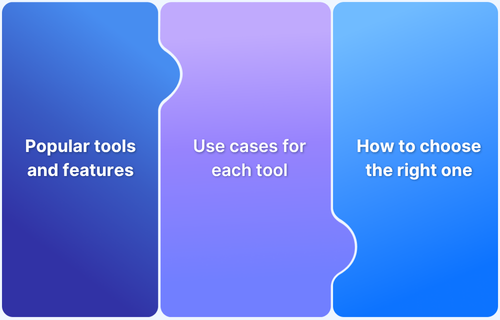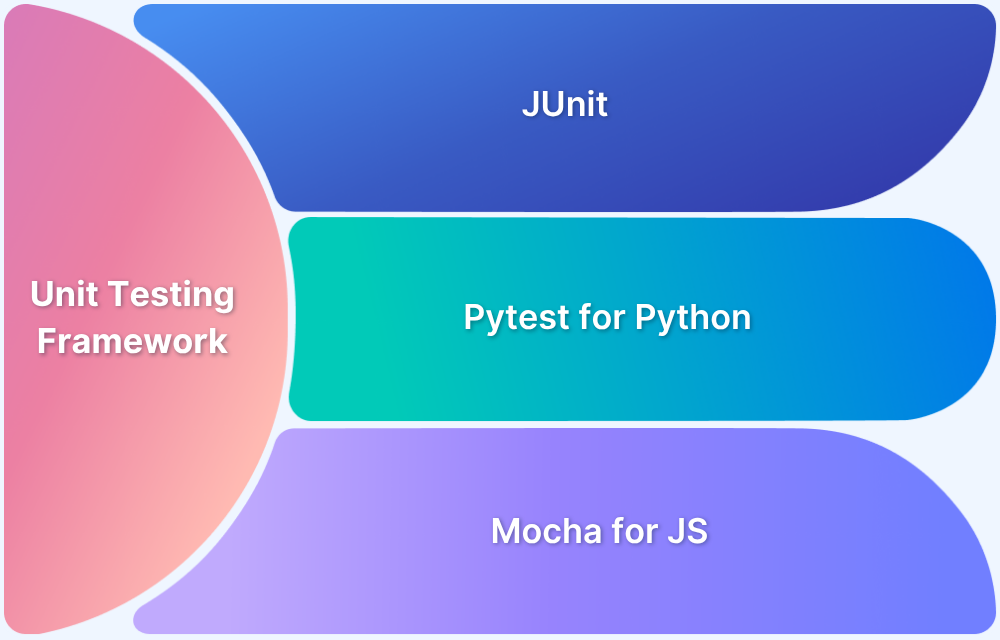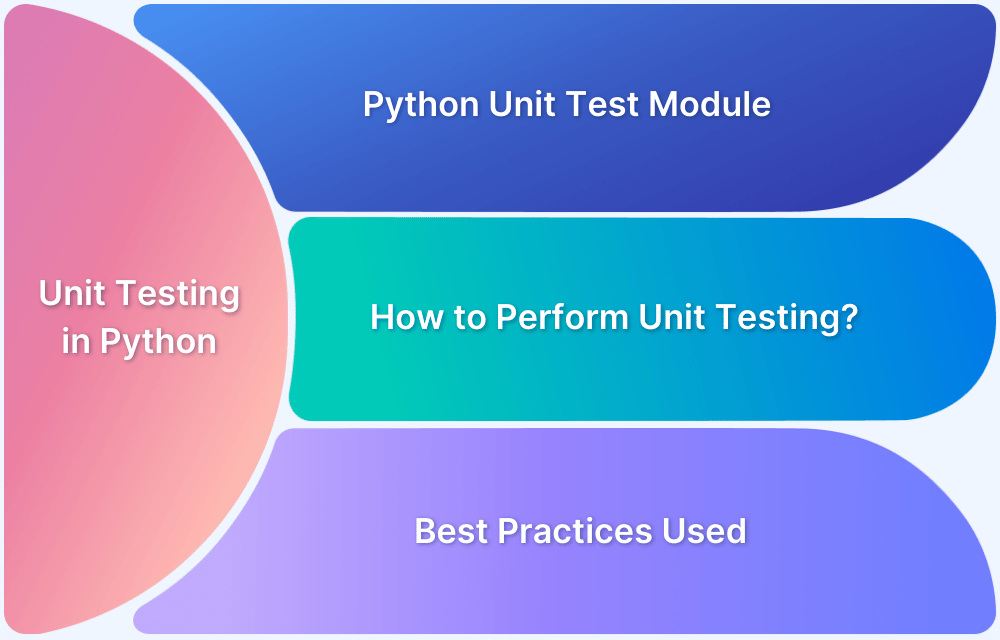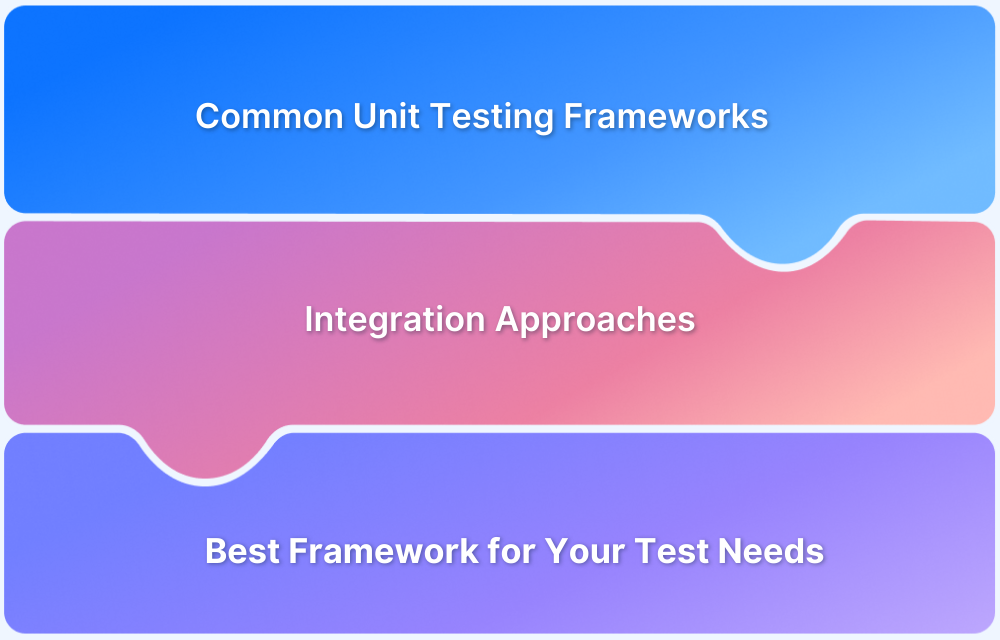Unit testing is an essential practice in software development. Selecting the appropriate tool for unit testing can significantly affect your project’s progress and the code’s quality.
Testing becomes more challenging as your project grows. To handle that complexity, you need tools to automate, optimize, and integrate testing procedures into your development pipeline.
Overview
Top 15 Unit Testing Tools
- JUnit
- NUnit
- MSTest
- HyperTest
- Mocha
- PHPUnit
- RSpec
- PyTest
- Cantata
- Mockito
- TestNG
- Karma
- TypeMock
- HtmlUnit
- Parasoft JTest
What are the Types of Unit Testing?
- Manual Unit Testing
- Automated Unit Testing
This article discusses 15 best unit testing tools that developers can use.
What is Unit Testing?
Unit testing verifies the most minor parts of an application, like functions, methods, or classes, to ensure they perform their intended operations under various conditions.
This early-stage testing ensures that code components work independently before they are integrated into larger systems.
Also Read: What is Integration Testing
It’s particularly effective when automated since automated unit tests can be executed frequently throughout the development cycle.
By integrating unit tests into Continuous Integration (CI) pipelines, developers can ensure that new changes don’t break existing code, which makes for a much smoother and more reliable workflow.
What are Unit Testing Tools?
Using tools makes it easier to create, manage, and run unit tests.
Whether setting up mock objects, verifying assertions, or generating reports, unit testing frameworks streamline the testing process.
They allow for better test automation, higher code coverage, and more straightforward integration into CI/CD workflows.
Here are some key features to look for in unit testing tools:
Key Features of Unit Testing Tools
Below are some key features of unit testing tools:
- Automation: Automatic execution of test cases, so you’re not always manually running tests.
- Mocking and Stubbing: Simulate dependencies to focus solely on the tested unit.
- Code Coverage: Measure how much of your code is being tested.
- Assertions: Ensure that the output matches the expected results.
- Test Reports: Generate detailed reports to quickly identify what’s working and what’s broken.
- CI/CD Integration: Easily hook into build and deployment pipelines.
Why are Unit Testing Tools Important?
Using the right unit testing tools will improve code quality, speed up development, and give developers confidence in making changes.
They are critical for maintaining good test coverage and ensuring refactoring efforts don’t introduce new bugs.
Efficient tools also help with automation, allowing you to validate code changes continuously and preventing integration issues from cropping up later.
How does Unit Testing Work?
Here is a step-by-step guide on how unit testing works:
Step 1: Developers write test cases based on code logic and expected outcomes.
Step 2: Tests are executed automatically using a testing tool.
Step 3: The testing tool verifies if the output matches the expected results.
Step 4: A detailed test report is generated, highlighting the status of each test.
Step 5: Based on the report, developers refactor the code or write additional test cases to cover untested parts.
Top 15 Unit Testing Tools
Here are the top 15 unit testing tools:
1. JUnit
A core component of Java testing, JUnit is well-liked for its ease of use and active community. It is a favorite for test-driven development (TDD) since it works well with technologies like Maven and Gradle.
Advantages:
- Highly compatible with Java-based build tools like Maven and Gradle.
- Rich ecosystem of plugins for CI systems like Jenkins integration, reporting, and coverage.
- Encourages behavior-driven development (BDD) and test-driven development (TDD).
Disadvantages:
- It has limited built-in capabilities for mocking services, which require additional libraries like Mockito.
- Slower for large-scale projects due to serialized execution.
- Does not support multi-threaded testing natively.
Why to Consider: JUnit is widely recognized within the Java community and provides extensive assistance for creating repeatable and manageable tests. It is mainly known for its simplicity and robust community support, and it works well with building technologies like Maven and Gradle.
2. NUnit
If you’re a .NET developer, NUnit is one of the most flexible testing frameworks available. It supports parallel execution and parameterized tests, crucial for scaling large test suites. It integrates seamlessly with Visual Studio, making it a go-to tool for .NET developers.
Advantages:
- Supports parameterized and parallel testing, enhancing scalability.
- Easily integrates with Visual Studio and other .NET development environments.
- Open-source, with active community support and frequent updates.
Disadvantages:
- Large test suites may experience performance bottlenecks.
- Requires additional setup for mocking external dependencies.
- Slightly steeper learning curve for beginners.
Why to Consider: NUnit is the go-to testing framework for .NET developers, parameterized tests, ease of setup, and active community support make it a reliable choice for scaling .NET apps.
Read More: JUnit vs NUnit: Framework Comparison
3. MSTest
MSTest is baked into Visual Studio and offers a quick and native testing solution for .NET developers. It supports data-driven testing and provides an easy setup, but it lacks some advanced features like parallel testing found in other frameworks.
Advantages:
- Full integration with the Microsoft development stack, making it ideal for Windows developers.
- Supports data-driven testing, enabling flexible test case definitions.
- Simple to set up and use with Microsoft’s developer tools.
Disadvantages:
- Limited features compared to other frameworks like NUnit and xUnit.
- Performance issues when handling large test suites.
- Requires additional configurations for cross-platform testing.
Why to Consider: MSTest is Microsoft’s official testing framework for .NET, providing deep integration with Visual Studio and Azure DevOps. It is ideal for teams using Microsoft’s development stack and seeking good integration with Azure DevOps.
Read More: NUnit Vs XUnit Vs MSTest: Core Differences
4. HyperTest
HyperTest optimizes unit testing with cloud-based infrastructure, focusing on speed and scalability. It’s built for teams that prioritize fast test execution in CI/CD pipelines. It automatically distributes tests across its cloud infrastructure, allowing for parallel execution and significantly reducing test times.
Advantages:
- Blazing-fast test execution through cloud infrastructure.
- Automatically scales to handle large test suites without performance degradation.
- Seamless integration with CI/CD pipelines for continuous testing.
Disadvantages:
- Limited offline capabilities; heavily reliant on cloud services.
- Higher cost due to cloud infrastructure.
Why to Consider: HyperTest accelerates unit testing with features like parallel test execution and real-time feedback. It is best for speeding up large test suites with parallel execution across cloud servers.
5. Mocha
Mocha is a flexible testing framework for JavaScript, particularly effective for testing asynchronous code. It runs on Node.js and supports various assertion libraries like Chai, allowing developers to design their test suites. Mocha’s custom reporters offer detailed feedback.
Advantages:
- Strong support for asynchronous testing, making it ideal for modern JavaScript applications.
- Easily integrates with assertion libraries like Chai.
- Customizable reporter options for detailed feedback.
Disadvantages:
- No built-in assertions or mocking; requires additional libraries.
- Complex test setups for large projects.
Why to Consider: JavaScript and Node.js apps are ideal for Mocha’s adaptable testing framework. It provides flexibility in creating unique testing suites for client-side and server-side code, supporting both synchronous and asynchronous testing.
Also Read: Unit testing for NodeJS using Mocha and Chai
6. PHPUnit
PHPUnit is the go-to testing framework for PHP applications, offering comprehensive support for test-driven development (TDD). It provides detailed feedback on test results and integrates seamlessly with CI tools like Jenkins. PHPUnit is known for its simplicity and strong community backing.
Advantages:
- Fully supports TDD workflows with easy test case creation.
- Detailed output and reporting for test failures and errors.
- Extensive documentation and community support.
Disadvantages:
- Limited support for parallel test execution.
- Mocking complex dependencies requires external libraries.
Why to Consider: PHPUnit provides excellent test documentation and assertions. It is designed with PHP developers in mind and is a mainstay in the PHP development community. It is lightweight, simple to use, and works with continuous integration technologies like Jenkins.
Also Read: Popular PHP Software Testing Tools
7. RSpec
RSpec is a popular Ruby testing framework known for its readability and behavior-driven development (BDD) focus. Its human-readable syntax makes tests easier to write and understand, promoting collaboration between developers and non-technical stakeholders.
Advantages:
- Highly readable syntax, making tests easy to understand and maintain.
- Strong support for BDD, encouraging better collaboration between developers and stakeholders.
- Extensive mocking and stubbing support for isolating tests.
Disadvantages:
- Slower execution compared to other Ruby testing frameworks.
- It requires additional configuration for running tests in parallel.
Why to Consider: RSpec is a powerful and expressive testing framework for Ruby. It promotes behavior-driven development (BDD), making writing human-readable test cases that enhance collaboration between developers and stakeholders easier.
8. PyTest
PyTest is a powerful and flexible testing framework for Python, known for its ease of use and scalability. It supports fixtures and plugins, enables reusable test setups, and offers parameterized testing to increase test coverage.
Advantages:
- Supports fixtures and plugins, allowing for modular and reusable test setups.
- Offers parameterized testing for enhanced test coverage.
- Integrates with various reporting tools and CI pipelines.
Disadvantages:
- Debugging complex test cases can be challenging.
- Limited parallel testing without additional configuration.
Why to Consider: PyTest is popular for its simplicity and scalability in Python testing. It’s an excellent choice for teams with complex Python applications, offering powerful fixtures, plugins, and detailed failure reports to improve testing efficiency.
Read More: Top 8 Python Testing Frameworks in 2024
9. Cantata
Cantata is a specialized unit testing tool for safety-critical embedded systems. It is perfect for industries like aerospace and automotive since it offers comprehensive support for industry standards like ISO 26262.
Advantages:
- Supports certification for standards like ISO 26262.
- Extensive support for code coverage and real-time analysis.
- Customizable to specific embedded system architectures.
Disadvantages:
- Expensive licensing, suited primarily for large enterprises.
- Limited flexibility for non-embedded projects.
Why to Consider: Cantata is designed for safety-critical and embedded systems, providing rigorous testing capabilities. It’s especially valuable in industries like aerospace and automotive, where compliance with strict standards like ISO 26262 is required.
10. Mockito
Mockito is a widely used Java mocking framework designed to simplify the creation of mock objects in unit tests. It allows developers to isolate the unit under test by simulating external dependencies. Mockito works seamlessly with JUnit, enhancing test coverage and reliability.
Advantages:
- Simplifies the mocking of dependencies in unit tests.
- Works well with JUnit for comprehensive test coverage.
- Reduces the complexity of testing by isolating the code under test.
Disadvantages:
- Limited use outside of Java-based projects.
- Requires careful setup for complex test environments.
Why to Consider: Mockito is perfect for Java developers who require a robust mocking framework. It makes creating mock objects easier and enables you to isolate the code unit being tested, which enhances test execution speed and reliability.
11. TestNG
TestNG extends JUnit’s capabilities, offering advanced features like parallel test execution and data-driven testing. This makes it ideal for large Java applications. TestNG supports flexible test configurations and offers better control over complex test setups than JUnit.
Advantages:
- Supports parallel test execution, making it highly scalable.
- Flexible test configuration with support for data-driven testing.
- Better suited for testing complex applications than JUnit.
Disadvantages:
- Steeper learning curve compared to JUnit.
- Lacks built-in mocking functionality.
Why to Consider: TestNG offers advanced features like parallel test execution and powerful configuration annotations. It suits large-scale Java projects requiring comprehensive testing and custom configuration.
12. Karma
Karma is a JavaScript test runner that allows you to execute tests in real browsers, making it essential for cross-browser testing. It integrates well with CI tools, ensuring continuous testing and feedback.
Advantages:
- Supports running tests across multiple real browsers for accurate test results.
- Integrated with CI tools for continuous testing and reporting.
- Works seamlessly with popular JavaScript frameworks like Angular.
Disadvantages:
- Slower performance when testing across many browsers.
- It requires additional setup for complex projects.
Why to Consider: JavaScript test runner Karma is excellent at executing tests in various browsers. Teams who need to verify the compatibility of their JavaScript code across a range of platforms and devices will find it ideal.
13. TypeMock
TypeMock is a powerful .NET testing tool that provides advanced mocking capabilities, such as mocking static and private methods. It is ideal for testing legacy code, allowing developers to create unit tests without extensive refactoring.
Advantages:
- Excellent for testing legacy code without requiring refactoring.
- Supports both TDD and BDD practices.
- Strong integration with Visual Studio and other Microsoft tools.
Disadvantages:
- High cost compared to open-source alternatives.
- The steeper learning curve for developers unfamiliar with its API.
Why to Consider: TypeMock is another commercial .NET testing solution well-known for its ability to simulate sealed, private, and static methods. Teams working on intricate .NET applications that require precise control over test mock behaviors will find it a good fit.
14. HtmlUnit
HtmlUnit is a lightweight, headless browser testing tool for Java applications, focused on testing web applications without a GUI. It supports JavaScript execution and real-time interactions with web pages, making it suitable for testing back-end logic of web apps.
Advantages:
- Fast and lightweight, perfect for testing web applications without a graphical user interface.
- Allows JavaScript and real-time interaction with web pages.
- It is well-suited for integration.
Disadvantages:
- Limited functionality for complex UI interactions.
- Does not fully support modern JavaScript frameworks.
Why to Consider: HtmlUnit is a lightweight, headless browser designed for unit testing web applications in Java. It’s perfect for applications where full browser automation is not necessary but accurate simulation of HTTP and JavaScript behavior is critical.
15. Parasoft JTest
Parasoft JTest is a comprehensive Java unit testing tool for enterprise applications. It offers automated unit test generation, code coverage, and static analysis features, making it ideal for large teams focused on code quality and compliance.
Advantages:
- Automated code analysis and coverage tools for large codebases.
- Seamless integration with enterprise CI/CD systems.
- Offers regression testing and static analysis in addition to unit tests.
Disadvantages:
- Expensive, with a cost-prohibitive licensing structure for small teams.
- Overkill for small-scale projects, primarily suited for large enterprises.
Why to Consider: Parasoft JTest is highly suited for large enterprise applications, offering automated unit test generation, static analysis, and code coverage tools. It is ideal for organizations focusing on code quality, security, and compliance.
What are the Types of Unit Testing?
There are two types of unit testing as mentioned below:
Manual Unit Testing
Manual unit testing is beneficial for small projects as it’s simple and requires no special tools or infrastructure.
However, it is time-consuming and prone to human error, especially as project complexity grows. The need for continuous human interaction makes it less ideal for larger projects or those requiring frequent updates and changes.
Automated Unit Testing
Automated unit testing is efficient for large, complex projects. It saves time by running tests automatically and consistently, reducing human error. It also integrates well with development workflows, allowing for continuous testing and faster feedback.
However, setting up the necessary tools and infrastructure can be time-consuming and challenging, particularly for smaller projects.
How to Select the Best Unit Testing Tool
Below are some key factors to consider while selecting the best unit testing tool.
- Choose a tool compatible with your project’s language and frameworks.
- Make sure the integration goes smoothly with your development workflow.
- Strong community support ensures quick fixes and updates.
- Select tools with built-in support for mocking external dependencies.
- Choose a tool with clear documentation and an easy-to-use UI.
Challenges of Unit Testing Tools
Below are some limitations and challenges of unit testing tools.
- Steep Learning Curve: Some tools, particularly for large projects, require significant learning to master.
- Maintenance: Tests must be updated often in tandem with changes to the code.
- False Positives/Negatives: Poorly written tests can lead to incorrect test outcomes.
Best Practices for Unit Testing
Below are some best practices to help you efficiently perform unit testing:
- Ensure each test focuses on a single unit of functionality, making it easier to debug when issues arise.
- Prioritize testing critical paths in the code to ensure essential functionality is thoroughly validated, even if it means sacrificing some coverage.
- Use mocking and stubbing to isolate the unit under test and prevent external dependencies from affecting the results.
- Integrate tests into your CI/CD pipeline for automatic feedback. This will help you identify issues early and maintain code quality.
- Update and refactor tests regularly to reflect changes in the codebase, removing outdated tests to keep them relevant and accurate.
Conclusion
With numerous unit testing tools available, developers can select the one that best fits their project’s needs, whether it’s JUnit, NUnit, or PyTest. These frameworks enhance code stability, accelerate testing, and boost productivity and seamlessly integrated with Selenium.
To further streamline testing, BrowserStack Automate allows seamless integration with these frameworks, enabling testing across 3500+ real devices and browsers for improved accuracy and speed.






